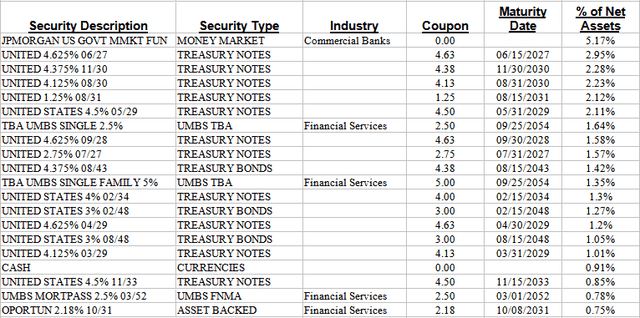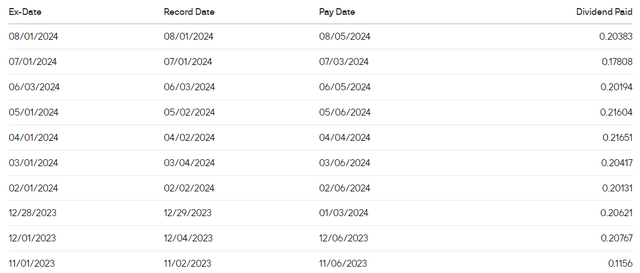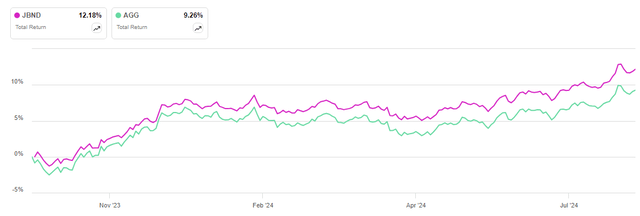DNY59
Introduction
I imagine that many bond investors view the iShares Core U.S. Aggregate Bond ETF (AGG) as the benchmark to measure all other bond ETFs against, at least those that are not segment focused. The JPMorgan Active Bond ETF (NYSE:JBND) believes by being actively managed and more diverse, their ETF will provide Alpha to bond investors. As the ETF’s homepage states, that has been the case so far. As of the end of June, the JBND has provided 170+ bps excess return since inception and 37 bps more yield vs the Agg index. While the active management is part of the reason, JPMorgan mentions that the Agg index excludes almost half the US bond market. Also, by not investing based on the Agg index, the asset allocation differs widely as shown in the next chart.
am.jpmorgan JBND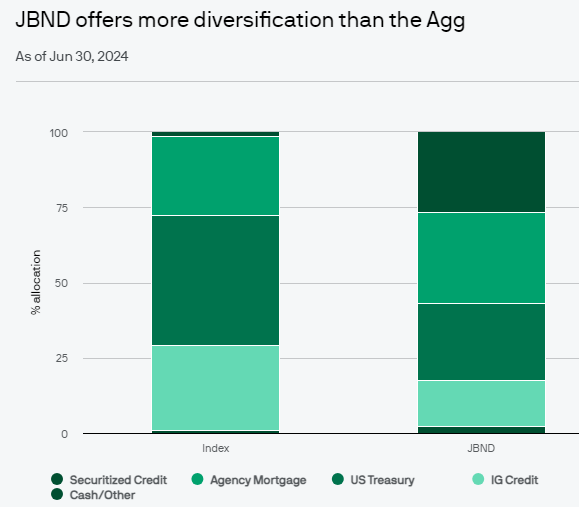
I will explore this more when I compare JBND to the AGG ETF later.
Based on its safer credit allocation and superior yield, I give the JBND a Buy rating; the AGG a Hold rating.
iShares Core U.S. Aggregate Bond ETF review
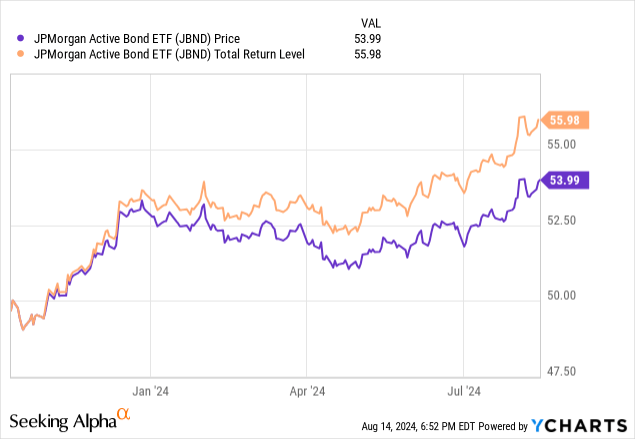
Seeking Alpha describes this ETF as:
JPMorgan Active Bond ETF is an exchange traded fund launched and managed by J.P. Morgan Investment Management Inc. The fund invests in fixed income markets of the United States. It primarily invests in U.S. dollar-denominated, investment grade corporate bonds, U.S. treasury obligations, including treasury coupon strips and treasury principal strips, other U.S. government and agency securities, and asset-backed and mortgage-backed securities that are rated A- or higher by S&P or Fitch or A3 or higher by Moody’s. The fund invests in securities with average weighted maturity between 4 and 12 years. It invests in securities of companies that are deemed socially conscious in their business dealings and directly promote environmental responsibility. The fund seeks to benchmark the performance of its portfolio against the Bloomberg U.S. Aggregate Bond Index.
Source: seekingalpha JBND
One factor that might be disagreed with by some investors is this ETF takes some ESG factors into consideration when building its portfolio. As the maturity goal indicates, the ETF focuses on intermediate- and long-term bonds. The AGG index includes all maturities.
JBND has $431m in AUM, up from just $320m at the end of the second quarter. At that time, the 30-day SEC Yield was 4.49%, with a Net YTM of 5.37%, which reflects the 25bps in fees charged by the ETF. The ETF has four managers whose industry experience averages 24 years.
Holdings review
Portfolio facts:
- Number of holdings: 714
- Average life (years): 7.43
- Average duration: 6.08
- Average yield: 5.61%
- Average bond price: $94.80
- Average coupon: 3.99%
The Asset allocation last reported was as follows:
am.jpmorgan sectors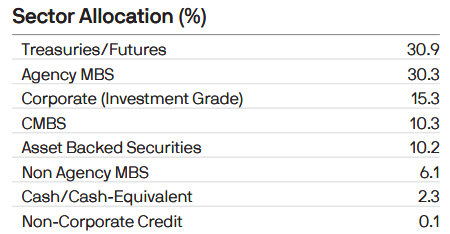
This allocation then drives the next data points, the credit rating allocation of the ETF where over 70% are in the highest two investment-grade letters. All rated bonds are investment grade as required.
am.jpmorgan ratings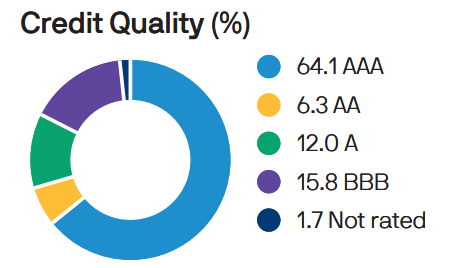
The next important allocation is the maturity schedule as it tells us how much matures soon and can be reinvested at a time when interest rates should be at this cycle’s peak.
am.jpmorgan maturities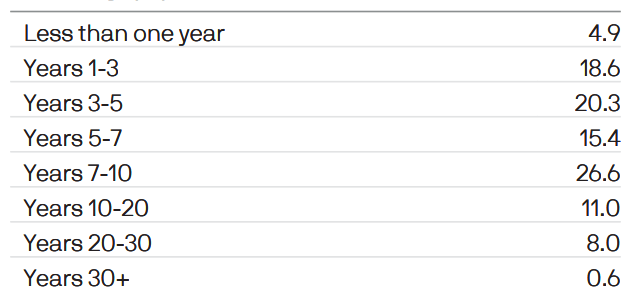
Here, we see under 5% of the portfolio will mature over the next year, by which time short-term rates could be down almost 200bps. The 20+% that mature after 2034 will benefit the most if long-term rates follow the FOMC’s lead and come down, though a normal yield curve would mean less so.
Top 20 holdings
Not counting the cash, these represent 27% of the portfolio. The largest corporate bond holdings are as follows, with only two with a weight over .3%.
am.jpmorgan largest corporate bond holdings
While Commercial Banks seem to dominate this allocation, they are only 4% of the total portfolio, under a 3rd of the corporate bond exposure.
Distributions review
The JBND site lists the yield at 3.94%. If JBND can maintain the $.20 per month, the annualized yield would come to 4.44%. That would be about 100bps more than the AGG ETF provides.
Comparing JBND to AGG
Since different managers might classify holdings differently, I will use Morningstar data for both ETFs for this comparison analysis, starting with sectors.
morningstar; compiled by Author
JBND mentioned they believe their ability to have a larger exposure to Securitized debt is to their advantage, and those assets are more than double the weight they have in the AGG ETF. That overweight in Securitized debt is reflected in the rating comparison too, with JBND owning more AAA debt than AGG. Morningstar gives a portfolio rating of AA to JBND, AA- to AGG.
morningstar; compiled by Author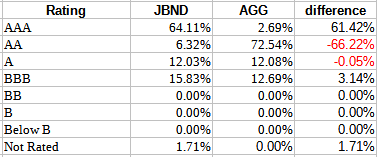
Like other features, the maturity allocations show large differences too, though less so.
morningstar; compiled by Author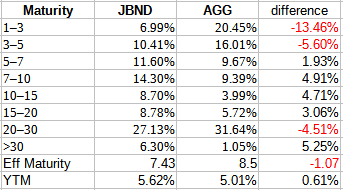
Last compare is coupon distributions, which are missing different percentage of the portfolio, both for some unknown reason.
morningstar; compiled by Author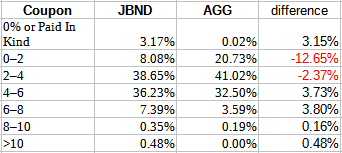
A better breakdown between 0% bonds and PIK would be great since those are radically different assets. The PIK’s could represent all the Not Rated holdings. PIK means the bond holder is getting other assets in lieu of interest payments due, possibly just more of the bond they hold.
Keeping in mind that JBND is just over nine months old, in that time they are outperforming the AGG ETF.
Analysis
- JBND provides a better yield for investors. JBND’s Weighted-average Coupon is 50bps higher than AGG’s so that yield advantage should continue to be the case.
- AGG’s maturity schedule is currently more favorable, as a higher percent will be available for purchasing new bonds while rates are higher than they probably will be in six to twelve months. This schedule also favors AGG at the long end, with its higher exposure to 30+ year debt.
- JBND has a ratings advantage over AGG, plus having a lower allocation to corporate bonds, which in theory are more risky than government debt.
- JBND investors need to be comfortable with its large allocation to Securitized debt, which covers mortgages and debt back by other assets, such a plane leases.
Conclusion
While each investor will need to interpret the facts about each of these ETFs in light of their investment goals and current portfolio allocations, based on its safer credit allocation and superior yield, I give the JBND a Buy rating; the AGG a Hold rating.
Portfolio strategy
For investors wanting fixed income exposure or looking to increase that allocation for whatever reason, selecting an ETF is one of the safer choices these investors have. When interest rates are in a steady state, using a broad index-based ETF is very logical. At other times, such as now, using either a short or long duration focused ETF should improve the overall return; with which based on where the investor thinks interest rate are moving too.
If others agree that rates are at their peak, there are now ETFs that invest in bonds that mature in a single year, with options going past 2030 to pick from. Some examples of these were covered in another article of mine. Another option is the more risky choice of owning a set of individual bonds that mature 5+ years from now, though almost all come with a Call risk. Several possibilities of 2029 bonds were covered in several of my articles.


